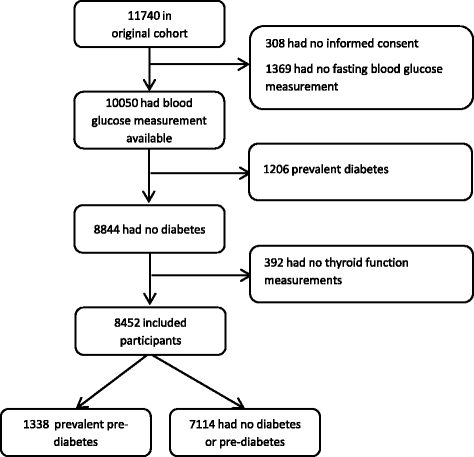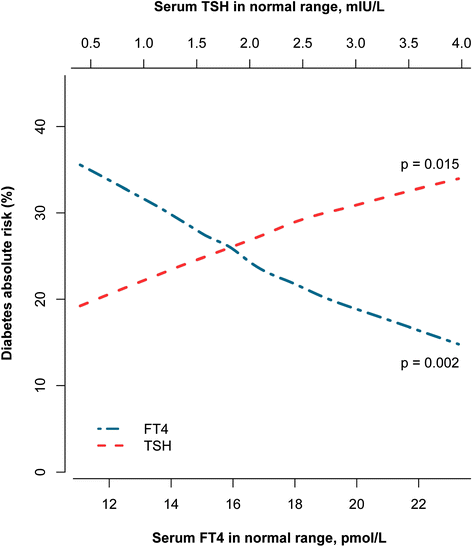Thyroid function and risk of type 2 diabetes: a population-based prospective cohort study
- PMID: 27686165
- PMCID: PMC5043536
- DOI: 10.1186/s12916-016-0693-4
Thyroid function and risk of type 2 diabetes: a population-based prospective cohort study
Abstract
Background: The association of thyroid function with risk of type 2 diabetes remains elusive. We aimed to investigate the association of thyroid function with incident diabetes and progression from prediabetes to diabetes in a population-based prospective cohort study.
Methods: We included 8452 participants (mean age 65 years) with thyroid function measurement, defined by thyroid-stimulating hormone (TSH) and free thyroxine (FT4), and longitudinal assessment of diabetes incidence. Cox-models were used to investigate the association of TSH and FT4 with diabetes and progression from prediabetes to diabetes. Multivariable models were adjusted for age, sex, high-density lipoprotein cholesterol, and glucose at baseline, amongst others.
Results: During a mean follow-up of 7.9 years, 798 diabetes cases occurred. Higher TSH levels were associated with a higher diabetes risk (hazard ratio [HR] 1.13; 95 % confidence interval [CI], 1.08-1.18, per logTSH), even within the reference range of thyroid function (HR 1.24; 95 % CI, 1.06-1.45). Higher FT4 levels were associated with a lower diabetes risk amongst all participants (HR 0.96; 95 % CI, 0.93-0.99, per 1 pmol/L) and in participants within the reference range of thyroid function (HR 0.96; 95 % CI, 0.92-0.99). The risk of progression from prediabetes to diabetes was higher with low-normal thyroid function (HR 1.32; 95 % CI, 1.06-1.64 for TSH and HR 0.91; 95 % CI, 0.86-0.97 for FT4). Absolute risk of developing diabetes type 2 in participants with prediabetes decreased from 35 % to almost 15 % with higher FT4 levels within the normal range.
Conclusions: Low and low-normal thyroid function are risk factors for incident diabetes, especially in individuals with prediabetes. Future studies should investigate whether screening for and treatment of (subclinical) hypothyroidism is beneficial in subjects at risk of developing diabetes.
Keywords: Diabetes; Prediabetes; Thyroid function; Thyroid hormone; Type 2 diabetes.
Figures



References
-
- Bertrand C, Blanchet E, Pessemesse L, Annicotte JS, Feillet-Coudray C, Chabi B, Levin J, Fajas L, Cabello G, Wrutniak-Cabello C, et al. Mice lacking the p43 mitochondrial T3 receptor become glucose intolerant and insulin resistant during aging. PLoS One. 2013;8(9):e75111. doi: 10.1371/journal.pone.0075111. - DOI - PMC - PubMed
-
- Verga Falzacappa C, Mangialardo C, Raffa S, Mancuso A, Piergrossi P, Moriggi G, Piro S, Stigliano A, Torrisi MR, Brunetti E, et al. The thyroid hormone T3 improves function and survival of rat pancreatic islets during in vitro culture. Islets. 2010;2(2):96–103. doi: 10.4161/isl.2.2.11170. - DOI - PubMed
LinkOut - more resources
Full Text Sources
Other Literature Sources

